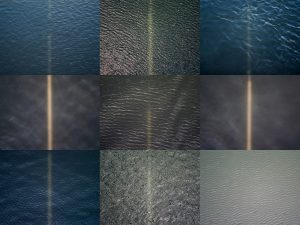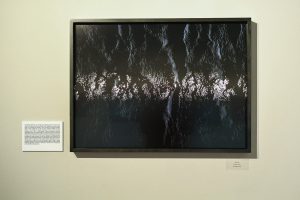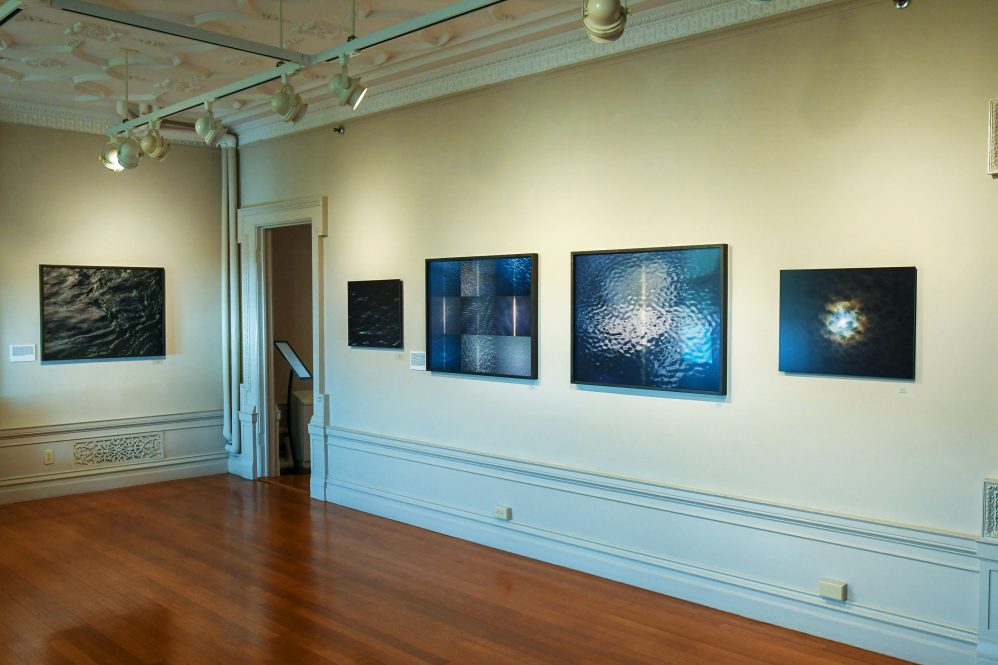One might think a photograph taken in the same place of the same thing, day after day, would portray a repetition of the same shapes, colors, and shadows of that place.
But, day after day, things change – dust accumulates, a person leaves their mark, plants sprout new leaves. The nine tiles of “Slit Grid” by New York City photographer Oskar Landi on display at the Alexey von Schlippe Gallery of Art at UConn Avery Point might show it best.
Each tile of the work depicts an image of the same body of water as looking through the slats of a walkway, yet each pane looks vastly different from the next.

In shades of blue, gray, and black, the color of the water shifts according to the light. The ripples of the surface dance differently in response to wind. The strength of the stripe of light shining through the two slats depends on the atmosphere – the stripe in one pane is obscured entirely, the result of smokey haze from wildfires.
This one picture, on display as part of the exhibition “Floating Points: Observing the Plastisphere with NASA,” perfectly describes what UConn marine sciences professor Heidi Dierssen describes as “rocket science.”
Quite simply, looking at an ocean’s surface to make observations or draw conclusions with only the naked eye or even through the most advanced satellite imagery in space, isn’t as easy as one might think.
Take, for instance, the idea that from space, the Earth is a blue marble, she says. It is, but not for the reason one might think – from space, the Earth’s oceans look midnight blue, maybe even black.
“When a photon goes into the ocean, it gets bent downward, and it keeps going downward until it’s absorbed by the water, phytoplankton, and other things in the water,” she explains. “What you don’t know is like only 1% or 2% get flipped backward, and once they get flipped, they have to go through an air interface and then through this atmosphere and guess what color the atmosphere is?”
Sky blue.
“The blue marble is blue because we have this amazing atmosphere,” she explains. “In fact, if our oceans were on Mars, we would call it the red marble. The truth is more than 90% of the photons coming off the ocean come from reflections. Understanding how light interacts with the ocean surface is key to trying to observe bits of floating white plastic on the ocean surface from space.”
Dierssen, who studies remote sensing of oceanic properties, met Landi about five years ago, not long after he came off a residency in the Arctic Circle during which he sought to photographically document the presence of microplastics in remote waterbodies.
Affirming that, yes, even the Arctic is tainted by human plastics, Landi and Dierssen connected with the thought they might be able to help one another.
Landi joined Dierssen’s research team to bring the group of scientists an artistic eye and special knowledge of the way light influences a subject – in this case the ocean surface. Is it possible to see floating plastics from NASA’s high-powered images of ocean color, the scientists wondered, since the technology is designed to detect ocean biology?

There are “truly trillions of little bits of white plastic all over the oceans. In fact, they’re congregated in the center of these big ocean gyres where water piles up in the center of ocean basins and we have downwelling. So, anything that floats sort of congregates there,” Dierssen says, explaining that even in what’s known as the “Great Pacific Garbage Patch” there isn’t a massive collection of plastic.
“There’s no island the size of Texas. If there was, my job would be super simple. Instead, it’s these little bits of white; what we call them is ‘floating points of light.’ And as you look around this room, you’ll get inspired by what Oskar got inspired by,” she says, gesturing to Landi’s photographs on display in the main room of the gallery.
They depict things like sun glint, one of the phenomena optical oceanographers like Dierssen must correct for, or remove from calculations, when looking at images of the ocean surface.
“You think of sun glint as this giant beam coming up,” she says. “In fact, it’s little facets of light that are reflections of the sun at very small scales. You can actually see these floating points of the sun. So that is something I have to remove and say, ‘How much sun is reflected,’ for me to see how many bits might be left that are plastics.’”
She says she also must consider the ocean foam from white caps, which from space looks like white plastic.
Look at Landi’s photograph, “Foamscape #1239,” Dierssen says, its black water covering the picture end to end with ripples of waves and a cascade of sunlight over a patch of sea foam smeared across the center.
Dierssen asks whether there’s glint on foam, something she wondered about for years.
Scientific models were unclear on the answer, and researchers hypothesized the answer was no. Photographs like Landi’s offered confirmation of that assumption, she says, adding that looking at “Foamscape” one can see the foam doesn’t have glint; it exists around the foam.
“Someone who has a special eye like you do is able to confirm that our models are doing a pretty good job,” Dierssen tells Landi. “I never knew that. I just assumed, ‘Well, foam doesn’t glint.’ But how would I know?”
‘Art is different from science – but here we are’
Adding an artist to her team of researchers has been one of the best things Dierssen ever did, she says. Even a video Landi produced, and is part of the exhibition, showing how a piece of plastic reacts in moving water has influenced her scientific models.
The relationship, she says, has prompted her to see the natural world differently, to look at water – the very things she’s studied for more than 20 years – for more than what it is.
“I’m a scientist, and art is different from science – but here we are in this collaboration,” she says, praising the relationship between science and art, each complementing the other.
Dierssen says she hopes to continue working with Landi, especially with the launch early next year of NASA’s PACE – Plankton, Aerosol, Cloud, ocean Ecosystem – mission, for which she serves as science team leader. She plans to be at Cape Canaveral when it launches and hopes Landi will lend his creative eye.
“I hope that my work will encourage discovery and adventure as well as reconnection with the natural environment, a fundamental need that too often is compromised by our modern lifestyles,” Landi says. “Nature is changing rapidly, but it’s still here. It’s everywhere. We just need to remind ourselves that we’re part of it and be aware of the beauty it always has to offer.”
While more appreciative now of the world’s beauty, Dierssen, in helping to develop “Floating Points,” admits she was out of her comfort zone.
Curated by gallery director Jeanne Ciravolo, the exhibition features Landi’s photographs, two of his short movies, and at least one scientific chart, courtesy of Dierssen, that details NASA’s Spaceborne Quantification of Ocean MicrO-Plastics (SQOOP) project, which was a massive study that considered atmospheric, wind, and sea surface conditions to see if microplastics were detectable with the current satellite technology.
The answer:
“I’ve got good news, people. No, we can’t,” Dierssen joked with a crowd gathered recently for the exhibition’s opening and a related Gallery Talk. “They have to be 100 to a thousand times more concentrated on the sea surface from today to really be observed. And even under the best conditions … we have looked every which way and even in the ‘Great Pacific Garbage Patch,’ at this point, they’re not concentrated enough.”
That means research will carry on. More photographs will be taken. And Dierssen and Landi will continue to explore floating points in the water.
Concurrent to “Floating Points: Observing the Plastisphere with NASA,” the Alexey von Schlippe Gallery of Art has “Waterbodies: Works by Marsha Borden, sTo Len, and Etty Yaniv” on display. This exhibition features contemporary art that centers on the damage humans have done to waterways and marine environments. Borden and Len received 2022 Connecticut Sea Grant Art Support Awards for their works. “Floating Points” and “Waterbodies” are open through Dec. 10. Gallery hours are noon to 4 p.m. Thursdays through Sundays on the second floor of the Branford House at the UConn Avery Point campus.



